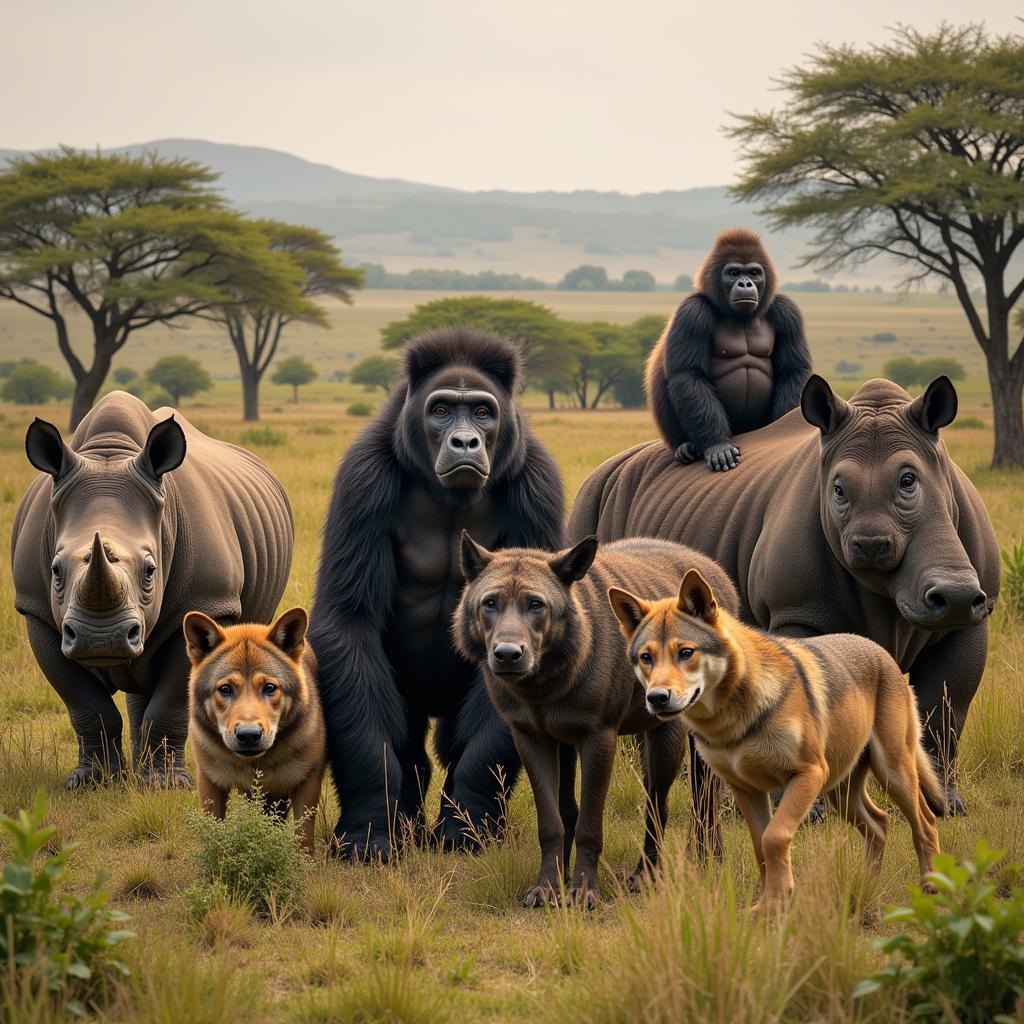Exploring the Wonders of the African Rift Valley
The African Rift Valley, a geological wonder spanning thousands of kilometers, is a testament to the Earth’s dynamic forces. This colossal fracture, a living laboratory of geological processes, offers a unique glimpse into the planet’s ongoing evolution and fosters an incredible diversity of life. It is a place where the Earth’s crust is literally pulling apart, shaping landscapes and ecosystems in remarkable ways. This article delves into the fascinating aspects of this natural wonder, from its geological formation to its rich biodiversity. East African Rift Valley offers a more specific view of this region.
The Geological Story of the African Rift Valley
The African Rift Valley is a series of contiguous geological trenches, extending roughly 6,000 kilometers from Lebanon in the north to Mozambique in the south. Its formation is a result of plate tectonics, specifically the divergence of the African plate. As the plates pull apart, the crust thins and stretches, creating a rift. This process is ongoing, with volcanic and seismic activity still prevalent throughout the region. This dynamic geology has resulted in dramatic landscapes, including towering volcanoes like Mount Kilimanjaro and Mount Kenya, deep lakes like Lake Tanganyika and Lake Malawi, and vast savannas teeming with wildlife.
What makes the African Rift Valley so unique is that it offers a real-time view of the continental drift process. This ongoing geological activity creates diverse habitats, influencing the evolution of unique plant and animal species. The valley’s landscape is constantly being reshaped, with volcanic eruptions and earthquakes adding to its dramatic topography.
Biodiversity Hotspot: Life in the Rift
The diverse habitats created by the rift valley’s unique geology, from lush forests to arid deserts, support an astonishing array of life. This biodiversity hotspot is home to numerous endemic species, meaning they are found nowhere else on Earth. The valley provides crucial habitat for iconic African wildlife like lions, elephants, rhinoceroses, and a diverse array of bird species. The lakes within the rift valley support a rich aquatic ecosystem, including unique fish species that have evolved in isolation. The Rift Valley lakes are particularly renowned for their cichlid fish diversity, showcasing the power of adaptive radiation.
Dr. Amani Njoroge, a renowned Kenyan biologist, explains, “The African Rift Valley is a crucible of evolution. The constant geological change has forced species to adapt and diversify, leading to the incredible biodiversity we see today.”
East African Rift Valley UPSC provides valuable insights for those preparing for the Indian Civil Services Examination.
Human History and the Rift Valley
The African Rift Valley is also significant for human history. Often referred to as the “Cradle of Humankind,” the region has yielded numerous fossil discoveries that have revolutionized our understanding of human evolution. The unique geological conditions, including volcanic activity and sedimentation, have created ideal circumstances for the preservation of fossils. The Olduvai Gorge, located in Tanzania, is one of the most important paleoanthropological sites in the world, with discoveries dating back millions of years. The rift valley continues to be a source of archaeological wonders, providing invaluable insights into our past.
Threats and Conservation Efforts
Despite its importance, the African Rift Valley faces several threats, including habitat loss due to expanding human populations, agriculture, and infrastructure development. Climate change is also a significant concern, impacting water resources and altering weather patterns. Recognizing the crucial need to protect this unique ecosystem, several conservation initiatives are underway, focusing on sustainable development, community involvement, and wildlife protection. Protecting the African Rift Valley is not just about preserving biodiversity but also about safeguarding a vital part of our planet’s heritage.
Professor Fatima Mbogo, a Tanzanian geologist, emphasizes, “The African Rift Valley is a fragile treasure. We must work together to ensure its preservation for future generations.”
What countries are part of the African Rift Valley?
The African Rift Valley spans numerous countries, including Ethiopia, Kenya, Tanzania, Uganda, Rwanda, Burundi, Democratic Republic of Congo, Zambia, Malawi, Mozambique, and parts of Lebanon and Syria. Each country offers a unique perspective on this geological wonder.
African Rift Valley Map shows the geographical expanse of this remarkable feature.
How long is the African Rift Valley?
The African Rift Valley stretches approximately 6,000 kilometers, making it one of the most extensive geological features on Earth. Its vast length contributes to its incredible diversity of landscapes and ecosystems.
A large near African Rift Valley offers a closer look at the scale of this incredible landform.
Is the African Rift Valley still growing?
Yes, the African Rift Valley is still actively growing, with the plates continuing to diverge at a rate of a few millimeters per year. This ongoing geological activity ensures that the Rift Valley remains a dynamic and ever-changing environment.
African Country in Great Rift Valley helps to understand the geopolitical context of the region.
Conclusion
The African Rift Valley is a testament to the power of nature, a place where geological forces shape landscapes and drive the evolution of life. From its towering volcanoes to its teeming wildlife, the rift valley offers a unique and unforgettable experience. It is a reminder of the Earth’s dynamic nature and the interconnectedness of geological processes and biological diversity. Exploring the African Rift Valley is not just a journey through space, but also a journey through time, unveiling the secrets of our planet’s past and present.
FAQ
- What caused the African Rift Valley? Plate tectonics, specifically the divergence of the African plate.
- Why is the African Rift Valley important? It is a biodiversity hotspot, crucial for human evolution studies, and a geological wonder.
- What are some of the threats to the African Rift Valley? Habitat loss, climate change, and human activity.
- What wildlife can be found in the African Rift Valley? Lions, elephants, rhinoceroses, diverse bird species, and unique fish species.
- Where is the “Cradle of Humankind” located? Within the African Rift Valley, particularly in areas like Olduvai Gorge.
- What is an endemic species? A species found only in a specific geographic area, like the African Rift Valley.
- How can I learn more about the African Rift Valley? Explore online resources, scientific journals, and travel documentaries.
Need more information? Check out these related articles on our website: The Great Migration, Volcanoes of East Africa, and The Cichlid Fish of Lake Malawi.
When you need assistance, please contact us. Phone: +255768904061, Email: kaka.mag@gmail.com or visit us at Mbarali DC Mawindi, Kangaga, Tanzania. We have a 24/7 customer service team.


